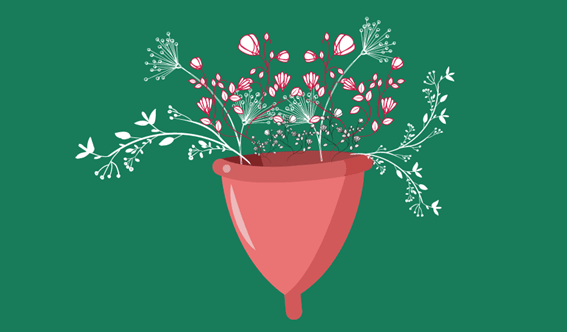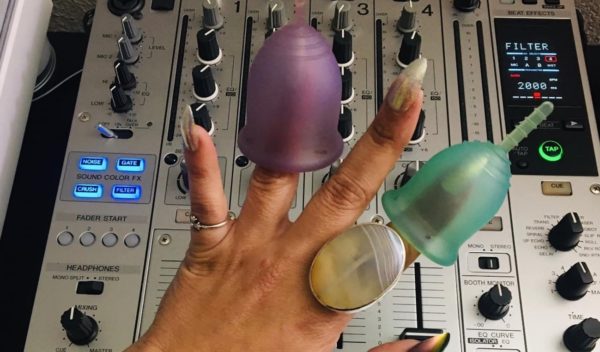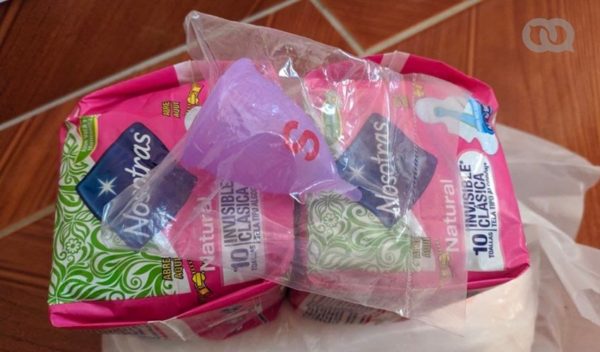Are Menstrual Cups Only for Cool Women in Cuba?
By Glenda Boza Ibarra (El Toque)

HAVANA TIMES – Ernesto pulled a face of disgust when he learned that a woman can collect her menstrual blood in a silicone cup that is placed inside the vagina, and can also reuse this recipient every month.
“How do you put it in? Doesn’t it spill if you turn it upside down? Doesn’t it get sucked up inside?” he asked his sister.
“You fold it and put it in. I don’t walk all lop-sided. The cervix doesn’t let anything “get lost inside”. Do you know what the cervix is?” his sister replied, at full speed.
The earliest patents of menstrual cups – the device that is inserted inside the vagina and collects the menstrual flow – date back to the 1930s. However, they only became popular in the early 2000s when they began to be produced in medical, hypoallergenic, and cheap silicone.
Today, more and more people are contemplating their use because they are reusable, eco-friendly and safe to use. Millions of women use them. You can find them on supermarket shelves for some years now, especially throughout Europe and the US, next to tampons and sanitary towels, products which are a great pollutant given the vast volume of waste they represent.
In Cuba, menstrual cups are still “strange”. Despite their proven benefits – for the environment, personal finances, and the female body -, a lack of information and access to this product has stopped them from becoming widespread across the country, where menstrual hygiene products are in great shortage.
The cup, an intimate friend
On a Cuban Facebook ad page, menstrual cups in sizes S and L are being sold for 750 CUP or 25 USD. “This will be the best purchase you ever make in your life,” the ad suggests. It’s right too.
The menstrual cup is designed to be easily folded and introduced into the vagina, where it immediately pops open and is ready to collect menstrual flow for several hours. It is them removed, emptied, rinsed out and is ready to be used again. It’s perfect for traveling, exercise or swimming. It can last up to 10 years if it’s looked after properly, which means a significant saving in financial terms, and provides great relief to the environment.
Even though a study published in the prestigious medical magazine The Lancet Public Health concludedthat “menstrual cups are a safe option for handling menstruation, and are being used worldwide,” it also recognizes the lack of conclusive data because there isn’t enough information available about their use.
Menstrual cups’ main “enemies” have been silence, and taboos.
“It hurts when you put it in”, “you get covered in blood”, “it causes vaginal infections”, “it breaks your hymen”, “it’s annoying when you walk”, are just some of the myths surrounding its use.
“It’s true that it does take time to get used to using it, but it’s worth it,” Cuban-American LeAnne Russel says. “I won’t say it’s really difficult in the beginning, but it does require patience, especially if you’ve never used tampons. I don’t even feel it now when I use it.”
In her scientific report, she reviewed data from another 43 studies and consulted over 3000 women. Seventy per cent said that they prefer menstrual cups to conventional products, such as tampons or sanitary towels.
This and other articles agree that a change in attitude is needed when you begin to use it.
Cuban woman Susana Hernandez received her first menstrual cup from a friend who thought she was a daring woman. He had been given one as a donation and couldn’t think of anyone he could give it to. It was 2017, and Susana still hadn’t heard anything about this product.
“I searched for information and I loved the idea of using it. I didn’t know that they came in different sizes. I was given a Divacup, and then three years later, I learned that there were smaller ones for women who hadn’t given birth. I’ve always used the regular size and it’s never bothered me or been an inconvenience,” Susana says.
Cuban DJ and music producer Bjoyce began using them after researching how to get rid of sanitary towels, which she found very uncomfortable and even smelled bad.
“I remember that I was in the middle of one of my periods and my constant debate about how uncomfortable sanitary towels were. I had to change them every five minutes; I couldn’t use pant because they would really bother me and I didn’t feel safe from a leak; and when I work gigs (performances, concerts) I have to stand, dance, etc. for hours at a time.”

Bjoyce researched ways to overcome these annoyances and concerns and discovered the menstrual cup. After reading and looking up other women’s experiences, she decided to buy her first cup… it’s been two years now since then.
“You can use the cup for everything – swimming, sports, etc. -, it’s easy to look after and it makes your period a much better experience,” pharmacist Liana Liz Perez explains. “It’s comfortable and durable.”
Is it only a trend in Havana?
In Bayamo, an OB/GYN confused the diaphragm – a contraceptive device made out of silicone – with a menstrual cup. Marlenis Torres says that she had gone to ask about the pros and cons of using the cup, and the doctor pretended that she knew about it.
“Ah, yes, it’s a diaphragm,” she told me during the appointment, and I didn’t want to disagree with her out of pity, because even she didn’t know what she was talking about,” Marlenis remembers.
The doctor isn’t the only one out of the loop. Menstrual cups aren’t very well known in Cuba.
Women from Cuba’s interior provinces had mixed reactions – mainly rejection – to an infographic shared on WhatsApp: “it looks uncomfortable”, “I’d never stick one of those things in me,” “and you have to take it out full of blood? gross!”
Women under 40 in Havana usually know what it is, and it seems to be more of a trend among cool women.
“I have never heard about this here in Camaguey, I don’t even know what you were talking about,” a university professor confessed.
Samantha Olazabal leads a project that promotes the use of menstrual cups and says that reaching communities outside the Cuban capital is one of its main objectives.
“We want to reach places outside of Havana and other cities, where women need these products more because they have little or no access to them. They don’t have family living abroad who can help them, or the financial means to buy them,” she says.
Almost always available in the capital, you can find menstrual cups selling for 650 pesos or more on online sale websites such as Revolico or on Facebook and Telegram groups.
In Cienfuegos, Yadiris Luis bought one, thanks to a recommendation from a friend living abroad. But it wasn’t very easy to find.
“They only had it in Small, and because I haven’t given birth yet, that’s the one I was told I should use,” she said. “I’m waiting for my next period to start using it. I have tried it a few times to start getting used to it, but sometimes I feel like I need a bigger one. I’ve pretty much run out of sanitary towels and I believe it’s a good investment.”
In Cuba, women in their reproductive years have the right to one packet of 10 nationally produced sanitary towels per month. They can be bought in drugstores for a subsidized price – 1.20 pesos -, but many women complain about the quality of them and delays in sales. Sanitary towels can come into drugstores once every three months or even less frequent.
You can also buy these products on the states retail network. However, while sanitary towels were one of the products that the Government promised “to protect and maintain sales in pesos” – you can only buy them in their US dollar stores.”
“You can find as many as you want in La Epoca – a USD store in Las Tunas,” Daniela Reyes says. “They cost between 1.30 and 3 USD, depending on the quantity, quality and brand of the packet.”
Daniela calculates that if a women uses a packet of 10 per month at the very least, she will have spent some 16 USD in a year. “I ordered my cup from abroad and it cost me 25 USD. It should last me over three years. And I don’t have to worry about “hoarding” sanitary towels when they appear. It’s a good investment.”
However, she says that even though she has talked about the cup with some friends from university, quite a few of them see it as something strange and they reject it. “They prefer sanitary towels, but I think it’s because they don’t know a lot about it. There are still a lot of preconceptions.”
Susana Hernandez agrees. She says they are used more in Havana, “where there is a movement of feminist women and more information about the subject. There are Queer, LTBTIQ+ movements, that are really dealing with body issues. How to take better care of it, treat it with more respect, looking after the environment and our surroundings… and the menstrual cup is a part of this.”
At Copa Menstrual Habana, Liana Liz Perez offers recommendations about using the cup. She is interested in making information and products reach other women, but she’s only been able to do this in capital for now.
“It would be a good idea for us to provide a regular supply of cups, among some of us, whether that’s by getting donations or even setting up a store,” Liana says. “I like to dream big and think that we could even have a Cuban brand one day. One that meets all health regulations and certification.”
My body, my period: my pride
Leaking, sanitary towels being visible in tight clothes, going to the beach or swimming pool, are just some of the concerns women have when they are on their period. The stigma that surrounds “periods” has made many a woman feel ashamed and even feel “dirty” if “accidents” happen during this time of the month.
“Very little is said about how to deal with your period in a healthy and innovative way,” Susana reflects. “Why do we have to carry on using sanitary towels when there are new products that are inaccessible, but will gradually come in as demand grows, and demand will grow as soon as more information is available.”
According to different interviewees, the menstrual cup can be so comfortable that some women have even forgotten they are wearing it. “Days on your period start being normal days,” they agree.
Susana Hernandez confesses that, sometimes, and depending on her menstrual flow, she will alternate between different female hygiene products. “Every body needs to learn its own rhythms and what it needs. I switch between cups and tampons, cups and sanitary towels, and what makes me feel better depending on the day of my cycle. The good thing about the cup is that it adjusts to your body and is comfortable. And if there’s one thing we need when we’re on our period, it’s to be comfortable!”

In addition to the adaptation process, one concern Cuban women have over and over again is the scarce availability of public restrooms with ideal conditions to empty, clean and reinsert the cup – running water, cleanliness, etc. “You just need to carry a bottle of water with you and things to wash it, and you can change yourself. Even in the most uncomfortable places, cleaning the cup and putting it back in hasn’t been hard now that I’ve learned how to use it,” Susana says.
According to DJ Bjoyce, there are so many advantages that “I would like all women to have the chance to try one.” “I can wear whatever I want, sleep comfortably and without having to worry, I can go to the beach, go hiking, I don’t have to spend money every month on my period, I’m helping the environment and I can enjoy myself with my partner without having to worry about having any accidents.” (Vaginal penetration is not possible when wearing the cup, but other sexual practices are).
They all agree that one of the advantages of the menstrual cup is how it helps them to learn more about their body. To learn, accept and, even, love their period.
“Ever since the first time I used the cup, I haven’t used tampons or sanitary towels again. It has helped me to learn more about my body and my cycle. Likewise, to cut down on waste that disposable products create. When I know my period is coming, I carry the cup with me, and it’s helped me to prevent some uncomfortable situations when I have to run out and look for something. I’ve saved a lot of money and time too,” LeAnne Russel says.
“I know that there are women who will never be able to use the cup. It’s not for everyone, but you have to try it at least,” Daniela says.
“I always advise women to be daring and open when trying new ways to deal with their periods. It’s a life-changing experience,” Bjoyce says.
“The female cycle (especially menstruation as a physical manifestation) has been and continues to be taboo in society. However, in many ancestral cultures, women’s reproductive capacity, the many energies linked to this process that is organically rhythmic, were sacred,” Liana argues.
“Periods are beautiful, it’s there, you have to love it, it’s not taboo. It’s a process in which your body gets rid of waste, cleans you and you have to love it too,” Susana Hernandez concludes.





From what I gather, for many decades of “revolution” feminine hygiene products have never been a big priority. It doesn’t take a genius to guess why. And low and behold, the US embargo is NOT the reason. The same goes for not producing enough food for the people, but that’s a whole other topic. Why most women in Cuba, those without relatives abroad, have to scrounge for sanitary napkins or invent rags or whatever, many months of some years, is outrageous! Isn’t anybody in the Communist Party or its government held accountable for this? Or is the excuse that the leaders have other more important priorities?